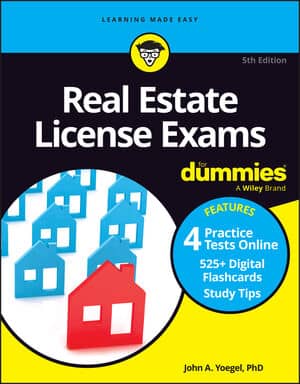Appreciation and depreciation are issues that come up frequently on the Real Estate License Exam. Appreciation is an increase in a property’s value caused by factors like inflation, increasing demand, and improvements to the property. Depreciation is a decrease in the value of a property caused by lower demand, deflation in the economy, deterioration, or the influences of other undesirable factors.
People always are interested in how much more they can sell their property for than what they paid for it. They may not want to consider a loss to their property’s value, but that can happen, too. A real estate agent is expected to be able to track increases and decreases in a property’s value and to apply market increases to specific properties.
So if the overall real estate market values in an area have increased by 10 percent during the last year according to government or other statistics, you need to be able to apply this increase in value to a specific property. By the way, not only market values can increase. Here’s some math for real world problems.
You bought a house for $200,000 and five years later sold it for $250,000. What is the rate at which the house appreciated?
The formula for this type of problem has two parts:
New value – old value = change in value
Change in value ÷old value = percent of change in value
$250,000 – $200,000 = $50,000
$50,000 ÷$200,000 = 0.25 or 25 percent
A different type of problem deals with a decrease in value. You bought a house for $200,000 and five years later sold it for $150,000. By what percentage did it depreciate?
The formula for this type of problem also has two parts:
Old value – new value = change in value
Change in value ÷old value = percent of change in value
$200,000 – $150,000 = $50,000
$50,000 ÷$200,000 = 0.25 or 25 percent
In either of these problems, you divide the change by the older value.
Keep an eye open for whether test writers ask you either of the preceding questions using the word “change” rather than “appreciate” or “depreciate.” For example: “By what percentage did the value of the house change?” In that case, your answers will have either a plus or a minus sign in front of them. The appreciation answer would be +25 percent, and the depreciation answer would be –25 percent.
Now for a reverse problem:
A house sold for $260,000, which is 130 percent of what you paid for it. How much did you pay for it?
The formula for this type of problem is
Current price (or value) ÷percent of original price = price (or value) sought
Notice in this formula that “percent of original price” is used, which is always 100 percent plus the change, which is +30 percent. Now how should you know this since the numbers were not given that way? Read the wording of the question carefully.
It said that the house sold for 130 percent of the original price, not 130 percent more than the original price. Another way to look at this is to say, “$260,000 is 130 percent of some number” — in this case, the original price. If you can say it that way, you know to divide the dollar amount you’re given by the percentage number.
With numbers the problem looks like this:
$260,000 ÷1.30 = $200,000
1.30 is the decimal equivalent of 130 percent.
Another problem similar to this reverses the question:
You bought a house for $300,000, which is 75 percent of what you sell it for five years later. What price did you sell it for?
Original price (or value) ÷the percent of selling price = price (or value) sought
$300,000 ÷0.75 = $400,000
Once again, you can say, “$300,000 is 75 percent of some number.”
In these types of problems, you can usually get the number you’re looking for by dividing the number you’re given by the percent that it represents.

